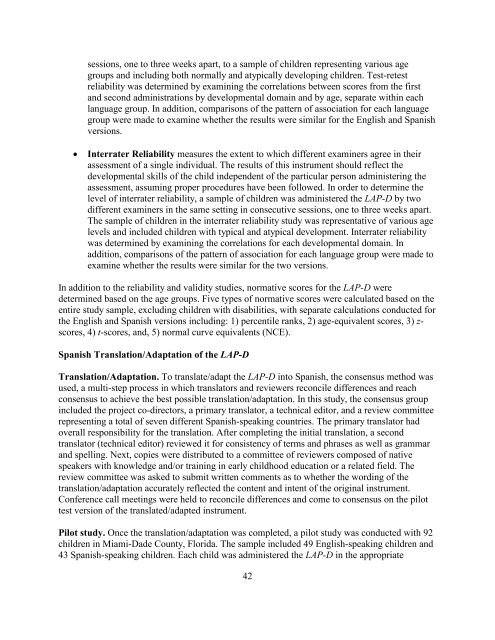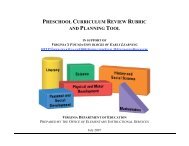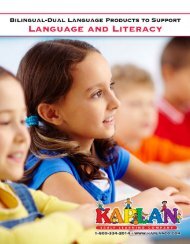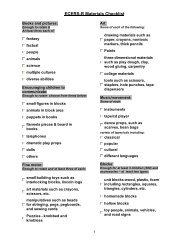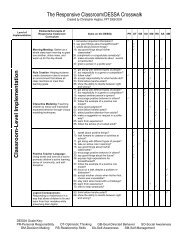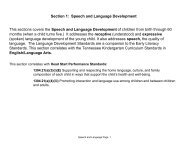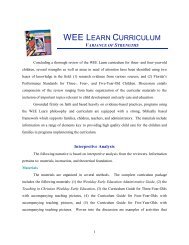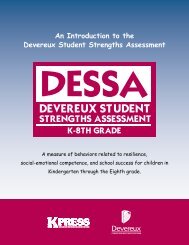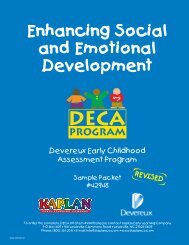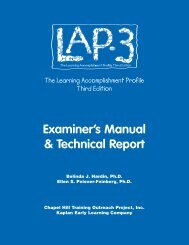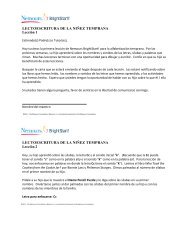Examiner's Manual & Technical Report - Kaplanco.com
Examiner's Manual & Technical Report - Kaplanco.com
Examiner's Manual & Technical Report - Kaplanco.com
- No tags were found...
You also want an ePaper? Increase the reach of your titles
YUMPU automatically turns print PDFs into web optimized ePapers that Google loves.
sessions, one to three weeks apart, to a sample of children representing various agegroups and including both normally and atypically developing children. Test-retestreliability was determined by examining the correlations between scores from the firstand second administrations by developmental domain and by age, separate within eachlanguage group. In addition, <strong>com</strong>parisons of the pattern of association for each languagegroup were made to examine whether the results were similar for the English and Spanishversions.• Interrater Reliability measures the extent to which different examiners agree in theirassessment of a single individual. The results of this instrument should reflect thedevelopmental skills of the child independent of the particular person administering theassessment, assuming proper procedures have been followed. In order to determine thelevel of interrater reliability, a sample of children was administered the LAP-D by twodifferent examiners in the same setting in consecutive sessions, one to three weeks apart.The sample of children in the interrater reliability study was representative of various agelevels and included children with typical and atypical development. Interrater reliabilitywas determined by examining the correlations for each developmental domain. Inaddition, <strong>com</strong>parisons of the pattern of association for each language group were made toexamine whether the results were similar for the two versions.In addition to the reliability and validity studies, normative scores for the LAP-D weredetermined based on the age groups. Five types of normative scores were calculated based on theentire study sample, excluding children with disabilities, with separate calculations conducted forthe English and Spanish versions including: 1) percentile ranks, 2) age-equivalent scores, 3) z-scores, 4) t-scores, and, 5) normal curve equivalents (NCE).Spanish Translation/Adaptation of the LAP-DTranslation/Adaptation. To translate/adapt the LAP-D into Spanish, the consensus method wasused, a multi-step process in which translators and reviewers reconcile differences and reachconsensus to achieve the best possible translation/adaptation. In this study, the consensus groupincluded the project co-directors, a primary translator, a technical editor, and a review <strong>com</strong>mitteerepresenting a total of seven different Spanish-speaking countries. The primary translator hadoverall responsibility for the translation. After <strong>com</strong>pleting the initial translation, a secondtranslator (technical editor) reviewed it for consistency of terms and phrases as well as grammarand spelling. Next, copies were distributed to a <strong>com</strong>mittee of reviewers <strong>com</strong>posed of nativespeakers with knowledge and/or training in early childhood education or a related field. Thereview <strong>com</strong>mittee was asked to submit written <strong>com</strong>ments as to whether the wording of thetranslation/adaptation accurately reflected the content and intent of the original instrument.Conference call meetings were held to reconcile differences and <strong>com</strong>e to consensus on the pilottest version of the translated/adapted instrument.Pilot study. Once the translation/adaptation was <strong>com</strong>pleted, a pilot study was conducted with 92children in Miami-Dade County, Florida. The sample included 49 English-speaking children and43 Spanish-speaking children. Each child was administered the LAP-D in the appropriate42


